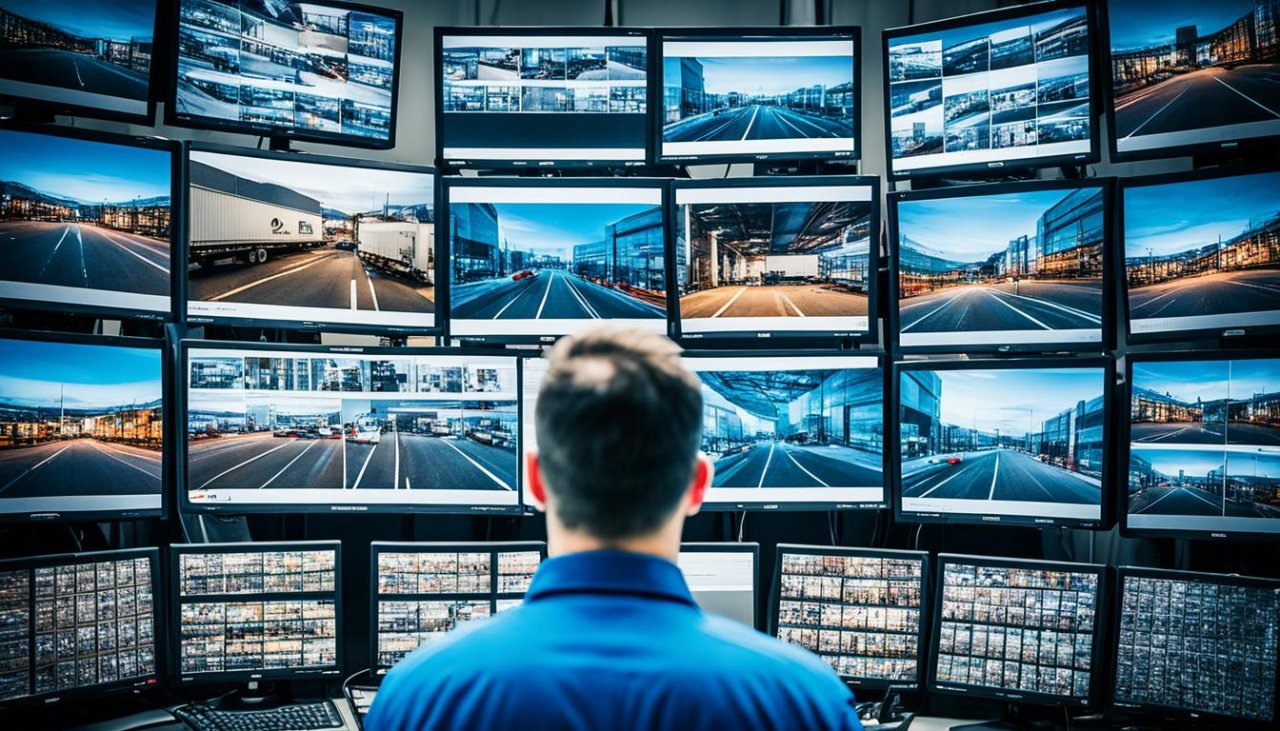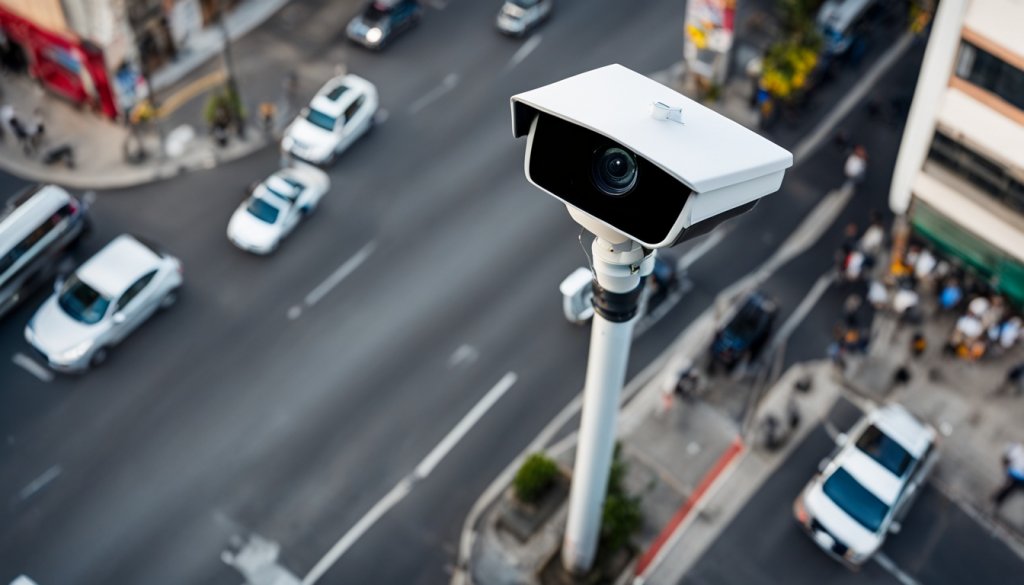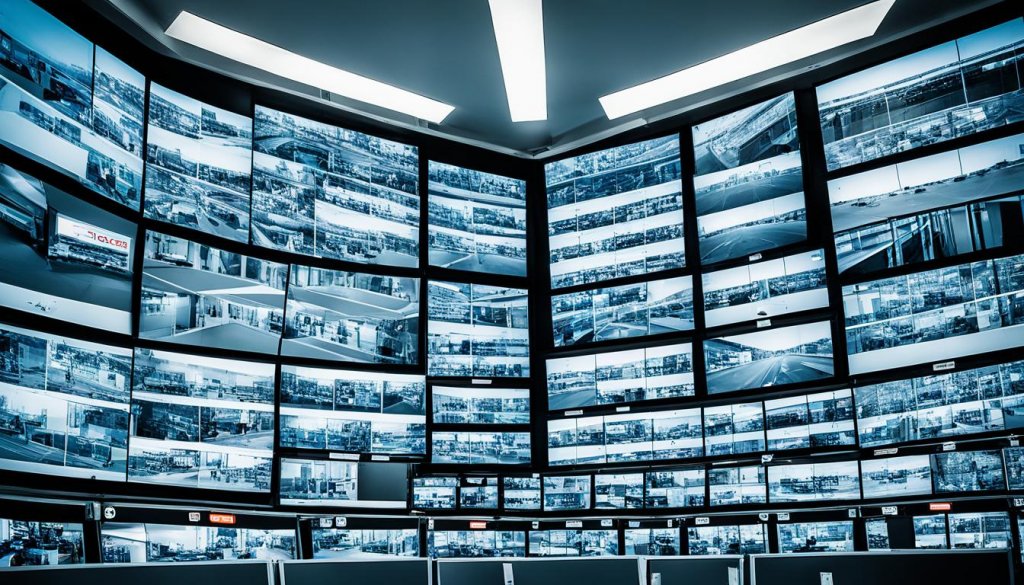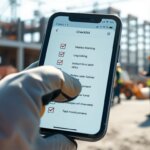Ever thought about how CCTV cameras can keep your place safe and stop crime? Today, over 1 billion CCTV cameras watch over us worldwide. They play a key role in keeping homes and businesses secure. But, just setting up a camera isn’t enough. Keeping it in good shape is crucial for it to work well and protect against theft and vandalism.

Key Takeaways
- Regular self-maintenance is crucial, with professional checks recommended at least once a year.
- Consider positioning cameras in areas less exposed to dirt to reduce cleaning frequency.
- Firmware updates are essential for improving performance and addressing vulnerabilities.
- Weatherproof housings can extend outdoor cameras’ lifespan.
- Proper maintenance prolongs the life of CCTV systems and ensures high-quality footage.
- Routine checks can help identify potential system failures and maintain continuous operation.
Understanding Continuous CCTV Monitoring
In today’s world, knowing about continuous CCTV monitoring is key for keeping places safe. This method uses the latest tech for always watching and recording what happens in certain spots. Many businesses now use it to boost their security.
What is Continuous CCTV Monitoring?
Continuous CCTV monitoring means always watching certain places with closed-circuit television systems. This tech lets operators keep an eye on things all the time. It gives property owners peace of mind. With a live camera service, security teams can act fast if something strange happens, making places safer.
Benefits of Continuous Monitoring for Security
There are many benefits to always watching with CCTV. For one, businesses can cut their security costs by over 60% a year. This setup also stops criminals from acting out, and it means help is always on hand if something goes wrong. So, using continuous CCTV is a smart move for staying safe.
The Importance of Regular Maintenance
Keeping a CCTV system in good shape is key for top performance and reliability. Regular maintenance stops problems before they start and boosts efficiency. Without regular checks, systems can get dusty and connections can come loose. This can make the images blurry, which weakens the system’s effectiveness.
A well-kept system means better security and peace of mind for me.
Why Regular Maintenance Matters
Regular maintenance is a smart way to protect CCTV gear. It helps fix small problems early, preventing big breakdowns and keeping surveillance going. Regular checks also make the equipment last longer and save money. Plus, it helps meet legal needs by keeping clear footage for important cases.
Impact on Image Quality and Performance
For CCTV monitoring, keeping an eye on image quality and performance is crucial. Dust on lenses or bad connections can ruin the video. I always check for blurry images or odd sounds and make sure the power is steady. Doing these checks keeps my security system working well and reliably.
Keeping Camera Lenses Clean
Keeping camera lenses clean is key for good CCTV monitoring. Dirt, dust, and smudges can build up, making images blurry. This can cut image quality by up to 50%, affecting how well cameras work.
Cleaning them regularly keeps the footage clear and useful. This shows why it’s important to keep cameras in top shape.
Best Practices for Cleaning Lenses
To clean camera lenses, use a soft cloth and a mix of mild soap and water. This avoids damage from harsh chemicals. Clean lenses every three to four months, or more if they’re outside a lot.
For indoor cameras, clean them every six months. Keeping lenses clean improves the image and helps the equipment last longer.
Common Mistakes to Avoid
Don’t use rough materials or strong cleaners that can scratch the lens. Such mistakes hurt the image quality and make monitoring harder. Not cleaning around the camera can cause more problems, so check it often.
By taking good care of the lenses, I can have a dependable security system. This gives me clear and accurate footage for monitoring.

Checking for Obstructions
Regular surveillance is key for good security. Making sure cameras can see clearly is often missed. Things like tree branches, building materials, or debris can block the view. It’s important to check for these around my cameras to keep them working well.
Identifying Potential Obstructions
Checking for objects in front of cameras helps keep surveillance constant. Plants growing or items moved can block the view. Using modern tools, I can check video feeds to find these issues quickly. This keeps my cameras working right.
Maintaining Clear Lines of Sight
To keep cameras working great, I trim branches and move materials away. This ensures they can see clearly. With clear views, surveillance is more accurate and covers important areas well. Staying on top of these issues helps my security plan.
Inspecting Cables and Connections
Keeping a CCTV camera monitoring service running smoothly means checking cables and connections often. I look for signs of damage like fraying, kinks, or tears. Even small damage can affect how well the system works, making it important to fix these issues quickly.
What to Look for during Inspections
During inspections, I often find issues like damaged cables and reel problems. If the video feed is poor, it could mean the connections are loose or damaged. Also, if the cable is hard to reel in or out, it might mean the reel needs adjusting.
Regular checks keep my CCTV system working well.
How to Prevent Disconnections or Damage
To avoid disconnections, I make sure all connections are tight and handle cables carefully. If a cable is damaged, I replace it right away to stop bigger problems. Checking the power supply and making sure all connections work well is key to a reliable CCTV service.
By focusing on these maintenance tasks, the system stays up and running, improving surveillance quality.
Testing the Recording System
It’s important to test my CCTV setup often to make sure it works well. This checks that my Digital Video Recorder (DVR) or Network Video Recorder (NVR) is okay. It also makes sure my real-time security cameras capture all the footage I need. Doing these tests helps avoid problems and keeps me confident in my 24/7 video surveillance.
Steps for Effective Testing
To test my recording system well, I take a few easy steps. First, I look at each camera’s video feed to ensure it turns on and works right. Then, I check the recorded videos for clear and complete footage. I keep an eye on the storage space of microSD cards to make sure they don’t fill up and stop recording.
Using cards like 64GB, 128GB, or 256GB affects how long footage is saved. So, I check this often.
Ensuring Accurate Time and Date Stamps
Checking the time and date stamps on footage is also key in my testing. These stamps are vital for finding video evidence later. If they’re wrong, it could cause confusion during investigations. Keeping these settings right helps with real-time security camera monitoring and keeps my 24/7 video surveillance trustworthy.
Updating Firmware and Software
Keeping my CCTV systems updated is crucial for their effectiveness and security. Regular updates boost system performance and shield against threats. This ensures my CCTV monitoring runs smoothly without interruptions.
Ignoring updates can put my system at risk. To avoid this, I keep up with the latest from the manufacturer. I always back up my data before updating to prevent losing any important information.
Why Updates are Crucial
Reports show that 57% of security devices face cyber threats. Updating my CCTV’s firmware and software is a must. Not doing so could leave my system open to attacks.
For sectors like healthcare and finance, following the law is a must. Regular updates not only improve performance but also meet legal standards. This includes HIPAA for healthcare and the Gramm-Leach-Bliley Act for finance.
How to Check for Updates
To keep my cameras in top shape, I regularly check for updates. Zivid makes this easy with tools like ZividFirmwareUpdater. This tool helps me see if my firmware needs updating.
Automatic checks through Zivid Studio mean I never miss updates. Firmware updates work best with certain SDK versions, ensuring my system runs well. Being proactive with updates helps my CCTV monitoring work better.
Identifying Weather Damage
Outdoor CCTV cameras face many weather challenges that can affect their work over time. It’s key to spot weather damage signs to keep CCTV monitoring effective. Signs like rust, water getting in, or corrosion mean protective steps are missing and fixes are needed. These signs can really reduce how well security cameras work.
Signs of Weather Damage on Outdoor Cameras
Outdoor cameras can show weather damage signs. Look for rust on metal parts, moisture inside the camera, and seals or coverings getting worn out. If I see these problems, fixing them quickly is a must to stop more damage. This keeps the system working right and safe.
Protective Measures for Various Weather Conditions
Protecting outdoor cameras from the weather is key. Using weatherproof housings and making sure they’re installed right is important. Setting cameras to handle extreme temperatures, rain, or humidity helps them work best. By doing these things, I keep my CCTV system reliable for real-time security checks.
Maintaining Optimal Camera Positioning
It’s crucial to place cameras right for good CCTV monitoring. Things like new buildings, changes in the yard, or updates to a space can shift camera views. Moving cameras around helps keep an eye on important spots. I check camera spots often to make sure they show clear, useful footage.
Adjusting Cameras for Changing Environments
Changes in the environment mean cameras might need to be moved. Using dome cameras inside and bullet cameras outside helps with flexibility. High-resolution IP cameras and PTZ cameras are great for adjusting to new situations. I watch for any issues with the current setup and adjust as needed.
Assessing Coverage Effectiveness Continuously
Checking camera coverage often makes sure all key areas are watched. Big areas might need several cameras for full surveillance. I mix camera types based on where they’re used; like bullet cameras for specific spots and wide-view dome cameras for public areas. Making sure every entrance and important spot is seen improves security and the service’s effectiveness.

Conclusion
In conclusion, keeping a strong CCTV monitoring system is crucial. It’s important to maintain and check it well to make sure it works right. By following the tips I shared, I can keep my surveillance quality high, make my equipment last longer, and keep everyone safe.
Regular checks and cleanings help cameras work better and keep the area secure. This means better protection for everyone, giving us all peace of mind. Continuous CCTV monitoring is more than just watching; it’s about keeping a safe space for my home or business.
Getting maintenance right means I can count on my CCTV system to respond quickly to threats. This shows my dedication to safety in a world where it’s key. By following these steps, I stay alert and ready, making every moment important.
See how FieldAx can transform your Field Operations.
Try it today! Book Demo
You are one click away from your customized FieldAx Demo!
FAQ
What is continuous CCTV monitoring?
Continuous CCTV monitoring means watching areas in real-time with closed-circuit television systems. It helps keep an eye on things all the time to boost security.
Why is regular maintenance important for CCTV systems?
Keeping CCTV systems in good shape is key. It stops them from breaking down, works better, and helps fight theft and vandalism 24/7.
How can I keep my camera lenses clean?
Clean camera lenses with a soft cloth and a mix of mild soap and water. Avoid harsh chemicals and rough stuff that could scratch the lens.
What should I look for when inspecting cables and connections?
Check cables for wear, fraying, or loose connections. This makes sure your CCTV system works well and sends data without problems.
How can I ensure that my CCTV system is capturing footage correctly?
Test the recording system often. Make sure the DVR or NVR works right. Also, check that the time and date stamps are correct.
Why are updates to firmware and software necessary?
Updates keep your system running smoothly and securely. They protect against bugs and make sure your CCTV system works all the time.
What are common indicators of weather damage on outdoor cameras?
Look out for rust, water damage, and corrosion on outdoor cameras. Fixing these issues early keeps your CCTV system working well.
How do I maintain optimal camera positioning?
Check camera angles and spots often. Make sure they cover everything well and adjust if things change and block the view.
What are the benefits of using a live camera monitoring service?
Live camera monitoring keeps your place under watch all the time. It makes your property safer, helps respond fast to incidents, and gives you peace of mind.
How can obstructions affect my CCTV monitoring?
Things like overgrown branches or building materials can block camera views. This makes your CCTV system less effective at watching over your area.
Author Bio
Co-Founder & CMO at Merfantz Technologies Pvt Ltd | Marketing Manager for FieldAx Field Service Software | Salesforce All-Star Ranger and Community Contributor | Salesforce Content Creation for Knowledge Sharing





